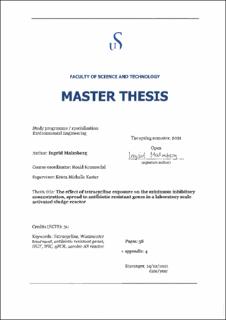The effect of tetracycline exposure on the minimum inhibitory concentration, spread to antibiotic resistant genes in a laboratory scale activated sludge reactor
Master thesis
Permanent lenke
https://hdl.handle.net/11250/2949811Utgivelsesdato
2021Metadata
Vis full innførselSamlinger
Sammendrag
Abstract Antibiotics, which are used to treat bacterial infections have saved countless lives and their development has been a huge step in modern medicine. Unfortunately, the overuse of antibiotics has led to the development of antibiotic resistance. An increasing number of bacteria strains are becoming resistant to antibiotics, where horizontal gene transfer (HGT) plays a crucial role in the spread of resistance. Wastewater treatment plants (WWTPs) are hotspots for HGT of antibiotic resistant genes (ARGs), as they contain large numbers of bacteria, which are exposed to low levels of antibiotics thus exerting selective pressure for the selection of antibiotic resistance genes.This study looks at the spread of ARGs by horizontal gene transfer in artificial wastewater, because WWTPs constitute the final barrier for ARGs and antibiotic resistant bacteria (ARB) before being released to the environment. Sludge from the local WWTP which was maintained in an aerobic sludge bioreactor was used to inoculate two aerobic AS reactors, one with the concentration of 1,4 µg/L tetracycline, and a control reactor without tetracycline. After addition of tetracycline to Reactor 2, the reactors were maintained for four weeks. Samples were taken from both reactors twice a week, where MIC values were determined for the different bacterial isolates at each sampling time. In addition, qPCR was used to quantify the total number of bacteria. Both the MIC values and qPCR suggests that subinhibitory levels of tetracycline led to a tendency for the selection of higher antibiotic resistance in the reactor where tetracycline was added.
